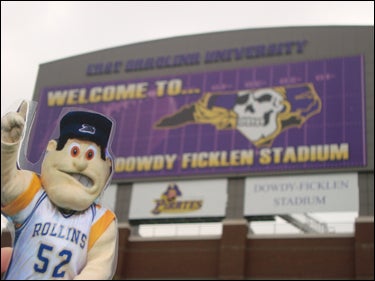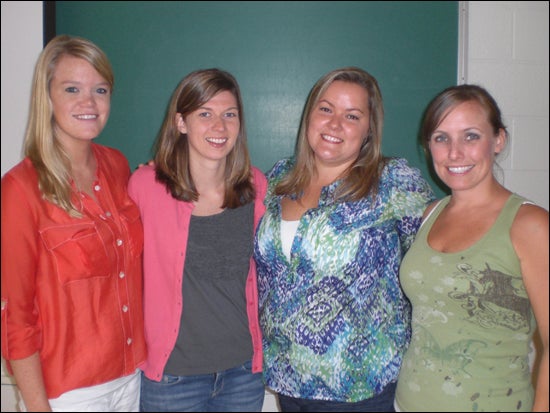ECU students blend technology, cardboard to engage learners
He’s flat. He’s purple. And he’s still somewhat sandy, but a cardboard pirate is all set to engage elementary school students with tales of his summer adventures.
He’s “Flat Pee Dee,” embossed with the image of East Carolina University mascot Pee Dee the Pirate. He’s just returned from Florida, where his experiences were recorded for use in the classroom.
Four graduate students in ECU’s College of Education sent Flat Pee Dee on his journey, in a collaborative project with Rollins College in Orlando. While Pee Dee went south, Rollins mascot Tommy the Tar toured eastern North Carolina.
The exchange models the popular Flat Stanley program, in which a cardboard cutout of a young boy travels from one elementary school to another, engaging students in learning about new places. ECU graduate students Stephanie Burress, Sylvia Dieu, Laura Wetherington and Beth Laughridge developed the project as part of collaborative work done in their course, Literacy in the Content Areas. The course is led by ECU faculty member Patricia Anderson in the ECU Master of Arts in Teaching program.
The students exchanged cardboard mascots with Lauren Brown, who is enrolled in a similar program at Rollins College. The mascots’ adventures, photographed in detail and published online, can help teachers instruct students at any elementary grade level in multiple content areas. Teachers can adapt the materials to teach subjects from history to geography, while adjusting the content as appropriate for the children’s ages.
Engaging children
Programs like these work well because schoolchildren get engaged, said Laughridge. It takes them beyond just studying to pass a test. They get excited about the project because they get involved in it and, equally important, it allows them to experience places and concepts far away from their homes.
<img src="http://news.ecu.edu/wp-content/pv-uploads/sites/80/2018/04/peedee-and-parrot_1.jpg" alt="While touring Sea World in Orlando, Fla., Flat Pee Dee interacted with a number of animals like the parrot pictured above, who may have had a story of his own to share. For additional images, visit the ECU Flat Stanley project at http://flatstanleyandliteracy.weebly.com/.(Photo courtesy of ECU Flat Stanley Project)” width=”425″ height=”319″ class=”size-full wp-image-49380″ /> While touring Sea World in Orlando, Fla., Flat Pee Dee interacted with a number of animals like the parrot pictured above, who may have had a story of his own to share. For additional images, visit the ECU Flat Stanley project at http://flatstanleyandliteracy.weebly.com/.(Photo courtesy of ECU Flat Stanley Project)“Some of these students have never been out of their home counties,” Laughridge said.
When Flat Pee Dee travels to Sea World in Orlando, Fla., she said, the students get to experience that adventure as well. In younger grades, teachers can use the Sea World encounter to teach children about different kinds of animals.
Older children can study different eco-systems or learn about animal conservation and environmental impact.
Tommy the Tar’s adventures included riding a tractor, planting beans and viewing corn and tobacco fields on Dieu’s family farm in Pitt County. While Florida’s teachers could use this experience to teach their students about eastern North Carolina’s agriculture and products, North Carolina students could learn about their home state as well, Dieu said.
“When we take the mascots on adventures, we learn things ourselves,” she said.
“These tobacco fields might be right in their front yards,” Laughridge said, “But the students may not know anything at all about farming; they don’t even notice it.”
The farming episode could teach students about the state’s history, environment, geography and agriculture, with applications for any grade level.
Helping teachers
Dieu said their work helped show fellow classmates in the MAT program how easy and effective a project like this could be.
“We wanted to show how it can be done and how you can incorporate it into the classroom,” she said. “Kids really get into it and take ownership.”

Rollins College mascot Tommy Tar visits Dowdy-Ficklen Stadium at ECU during a whirlwind tour of eastern North Carolina that included stops in Bath, Fort Fisher, the Wilmington EUE/Screen Gems film television studio, the USS North Carolina Battleship, the N.C. Estuarium, the Big Rock Blue Marlin Tournament in Morehead City, the Old Baldy lighthouse on Bald Head Island, Beaufort, the Greenville Town Common and a Pitt County tobacco farm. (Photo courtesy of the ECU Flat Stanley project)
Dieu said teachers who make friends while at ECU, then graduate and teach in different locations could share Flat Stanley projects with each other, regardless of the age level they teach.
Taking part in the projects also helps teachers and students take advantage of local resources. When first asked to participate in Orlando, Brown could not think of what she might photograph for Pee Dee’s visit.
“But she worked at Sea World!” Laughridge said. “It’s so easy to take for granted sometimes things that are right under our noses.”
This project helps teachers think outside of the box, Dieu said.
Adding a twist
The Flat Pee Dee project incorporated some of that kind of thinking as well. The students called it, “Flat Stanley with a twist.” The twist was technology.
They used technology to pull the project together quickly, communicating with cell phones, text messages and Facebook accounts. They used technology to present the adventures of both mascots on one web site, adding annotations on each site visited and links to more detailed information. The end result is available at http://flatstanleyandliteracy.weebly.com/.
“A Flat Stanley program is not limited,” Burress said. Teachers can adapt it as necessary for the needs of their students. She said students may use any image they choose for the cutout, even images of themselves.
“It’s a great product,” Wetherington said. “Putting it online makes it even better.”
Preparing to teach
The Flat Pee Dee project was a final assignment for the four ECU students. They completed their master’s degrees this summer through an intensive fast-paced course of study offered for students who have no teaching certificate upon admission. The program requirements include heavy class schedules, summer sessions and full-time internships while still taking classes in the evening.
“It’s 13 months to teaching,” said Anderson.
Adding the collaboration for the Flat Pee Dee project was a bonus, she said. The ECU students worked with MAT students doing the same program at another university. They compared experiences and learned from each other.
Anderson said the mascot exchange was one of many excellent submissions in a class where students made up their own requirements. Anderson provided goals and objectives and the students came up with a proposal for the work they would do, including group, individual and technical projects.
“All the results were so good. They were over the top,” Anderson said.
